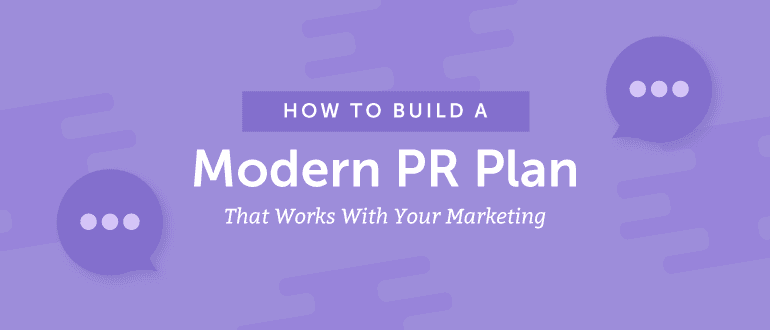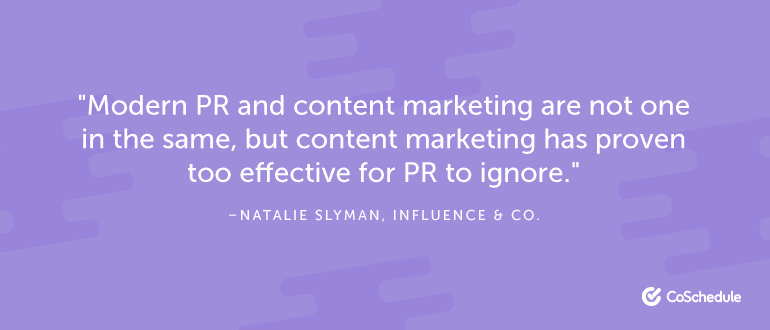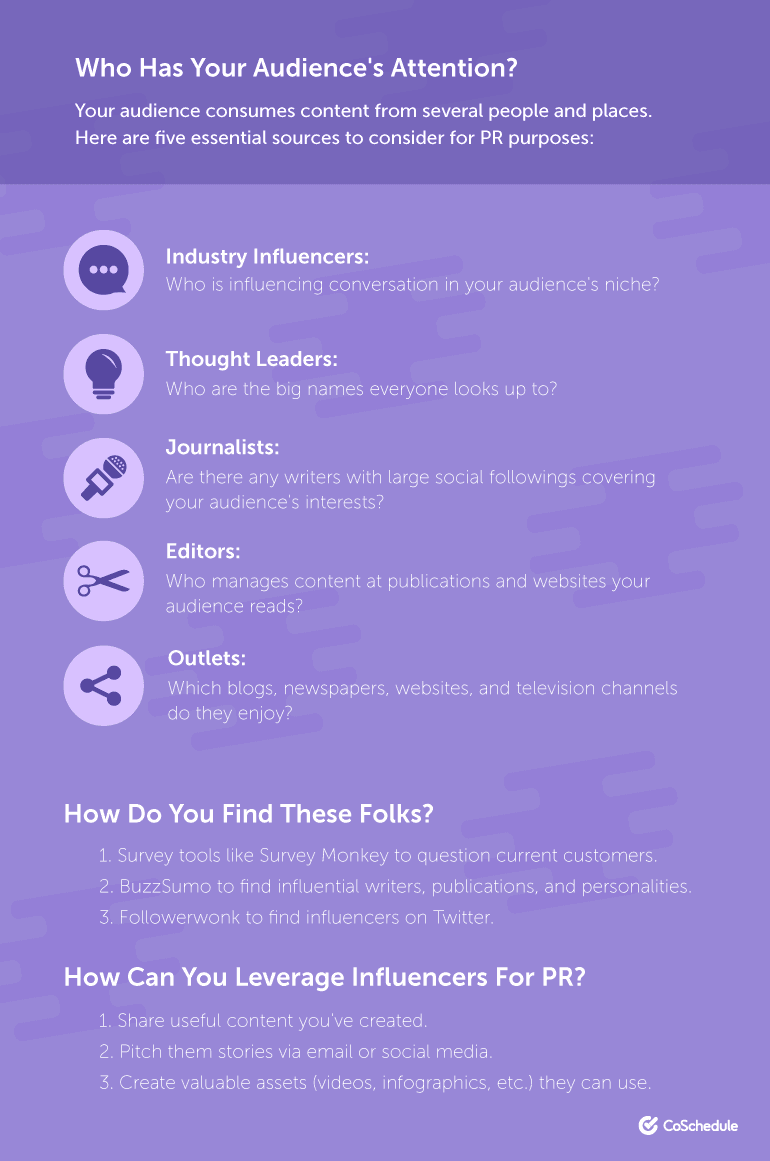How to Build a Modern PR Plan That Works With Your Marketing
 The job of any PR pro is basically in the title: manage and maintain a positive relationship with the public. This role has changed greatly over the years, however, and this makes the job more difficult than ever before.
The world of media and communications moves quickly, especially with the ever-increasing focus on social media and advancements in technology. Add to that audiences' increased expectations of trust, authenticity, and the rise of practices like content marketing, and it's clear PR really had no choice but to evolve or become largely obsolete.
In order to avoid falling behind, marketers need to learn how to effectively integrate their PR operations with other areas of marketing. This means that your PR efforts have to target the right audiences with the right tactics, and you should have measurable goals attached to each tactic you employ. That is where a PR plan comes in handy.
In this post we will cover the pieces of an effective PR plan, and then provide you with the steps and resources (free template, anyone?) to create one for your own business. Are you ready to be a PR master? Let’s go.
The job of any PR pro is basically in the title: manage and maintain a positive relationship with the public. This role has changed greatly over the years, however, and this makes the job more difficult than ever before.
The world of media and communications moves quickly, especially with the ever-increasing focus on social media and advancements in technology. Add to that audiences' increased expectations of trust, authenticity, and the rise of practices like content marketing, and it's clear PR really had no choice but to evolve or become largely obsolete.
In order to avoid falling behind, marketers need to learn how to effectively integrate their PR operations with other areas of marketing. This means that your PR efforts have to target the right audiences with the right tactics, and you should have measurable goals attached to each tactic you employ. That is where a PR plan comes in handy.
In this post we will cover the pieces of an effective PR plan, and then provide you with the steps and resources (free template, anyone?) to create one for your own business. Are you ready to be a PR master? Let’s go.
Start With Your Free Modern Public Relations Plan Template
This post offers tons of advice on creating a PR strategy that actually works concurrently with content marketing. But, did you know that marketers who document processes are 466% more likely to report success? It's true. That's why this post also includes a free PowerPoint template you can use to put this advice into practice, and document a plan you can execute. Get it free now, then read on.How to Build a Modern PR Plan That Works With Your Marketing by @natalieslyman via @CoSchedule
Click To TweetWhat Modern PR Looks Like
While PR looks different today than it did in the past, it still achieves similar goals. It's still press your company earns in a third-party outlet, and it still helps you establish credibility, boost brand awareness, and extend your brand positioning. The biggest difference is in its execution. Modern PR is much less transactional and more relational than ever before. In the past, marketing and PR teams could trade templated press releases to reporters in hopes of some self-promotional writeup published by whoever would pick up the story. The new PR is focused on your relationships with journalists, influencers, editors, and contributors at online publications and with the audiences you share with them. Trust is key, and it's earned by delivering valuable content to media contacts who can use it to provide value to their readers — the audience you're ultimately trying to reach. Audiences want engaging content from outlets they trust. When you pitch media contacts at those outlets truly valuable content and sources they can use to publish that engaging content (rather than stuffy, self-promotional releases), everyone wins. If some of this talk of "value" and "audience engagement" is ringing a bell to you, it's probably because content marketing focuses a lot on these things, too. Modern PR and content marketing are not one in the same, but content marketing has proven too effective for PR to ignore. That's why it's evolved beyond overt self-promotion en masse to offer more value — to audiences, media contacts, and the brands using modern PR alike.
Below are seven essential steps to building and implementing a modern PR strategy for your company:
That's why it's evolved beyond overt self-promotion en masse to offer more value — to audiences, media contacts, and the brands using modern PR alike.
Below are seven essential steps to building and implementing a modern PR strategy for your company:
1. Lay Out Your Brand Positioning Goals
Most people understand PR as a tool to really supercharge buzz around a one-time event or product launch. It's something that can quickly get a lot of people excited for a short time before fizzling out after that event or launch concluded. It is absolutely still a good tool for that — but how many events, launches, or other truly newsworthy events do you expect to happen in a year's time? Your company is doing important work for clients every day. How are your PR efforts elevating that work and, therefore, your brand overall? PR can also be used to help generate and sustain brand awareness, interest, and credibility that don't have an expiration date.PR can help generate brand awareness, interest, and credibility that don't have an expiration date
Click To Tweet Look beyond short-term goals for event registrants or demo sign-ups, and think about how you want to position yourself in front of your target audience. When you know how you want to be seen, you can better identify the outlets, writers, and editors that can help reinforce that brand image.
Look beyond short-term goals for event registrants or demo sign-ups, and think about how you want to position yourself in front of your target audience. When you know how you want to be seen, you can better identify the outlets, writers, and editors that can help reinforce that brand image.
2. Identify the Outlets That Reach Your Audience
Your audience is looking for content that's informative, engaging, and published on sites it trusts — like reputable online publications in their industry. Historically, publications were managed by journalists and traditional reporters and staff writers. But audience demand for that informative, engaging content has risen, and those outlets have grown their networks to include content from other sources, too, like industry leaders, experts, and individual contributors. To position your brand in front of the right audience, identify where they're getting their content. Which industry influencers, thought leaders, journalists, and editors do they trust? What outlets do they love? Start compiling a list of potential publications and contacts to pitch that align with your brand positioning goals and reach your audience.
Start compiling a list of potential publications and contacts to pitch that align with your brand positioning goals and reach your audience.
3. Create Strategic, High-Quality Content
Now, if you're not sending out press releases to those contacts you've listed, what exactly are you pitching? Content. This content is part of your PR efforts, so you might think it has to be really self-promotional to make the impact you're looking for. But that's not what modern PR is about. It's about value to your audience and your media contacts — which translates into value for your brand. When our team surveyed publication editors about the biggest problems they have with the content they're pitched, 79 percent said content is too promotional and 56 percent said it isn't a fit for their readership. So, as you're creating content to pitch editors and other contacts, ask yourself:- Does this content align with my company’s goals?
- Does it add value to readers?
- Does it align with the tone, topics, and opinions expressed in the publication I'm pitching?
4. Carefully Craft Your Pitches
Your pitches should be created with as much care as the actual content you create — because if your pitches get deleted, your content goes with it. Take the time to research your points of contact, customize your emails to demonstrate your message is worth reading, and remember the following points as you pitch your media contacts:Get Specific
These people likely receive plenty of pitches — why does it make sense for them to accept yours? To make your case, include a few key points from your content, in addition to an overall angle, article summary, and title suggestions. You should also provide an explanation of your company and any subject matter experts and sources included in your content. This helps your contact understand who you are, why you're a valuable, trustworthy source, and why your inclusion in this content is an important addition that can enhance audience engagement.Respect Their Schedules and Expectations
Your contacts aren't just watching their inboxes, waiting for a pitch from you. They are incredibly busy. They're creating their own content, collaborating with other writers and brands, and they're working on tight deadlines. Their time is valuable, and when you're asking them to fork over even a little bit of it, you must respect it by proving to them you care about more than just what's in it for you.
Lay the Groundwork for a Relationship
Modern PR isn't about quick, one-time wins; it's more relational than transactional. Be friendly, personable, and patient in your communication, and offer to revise or refine any content if needed. A good relationship benefits you both (and the audiences you share), and it's up to you to lay that foundation in your outreach. Back to the Top5. Develop (and Use) a Distribution Plan
Let's say your pitch goes well. This journalist or editor or influencer loves your idea and decides to use you as a source in an article he or she publishes. This is typically the exciting part, but it doesn't mean your work is done. You can't rely on these contacts to distribute this content for you. You have to do your part in maximizing press and getting this content to as many people as possible. Thankfully, there are so many ways to distribute content. Consider:- sending an email to your team with a request for them to share it on social media.
- sharing this content on your company's social media accounts.
- encouraging your sales team to send it to leads and in other outreach.
- putting some paid promotion behind it.
- adding it to your email signature.
- including an "As Seen On" badge on your site.
- including it in your newsletters or drip campaigns.
6. Keep Your Network Organized
This approach to modern PR isn't a one-and-done tactic. Obviously, pitching the same content to the same contacts isn't the idea here, but maintaining your relationships is critical. You don't want to work with a contact of yours to place content and then ghost them as soon as you've gotten your press. When you're implementing this plan, you'll want to organize and manage your own network. I recommend starting small with a simple spreadsheet that you and other members of your marketing and PR teams can contribute to. This gives you a centralized place to store information about your media contacts, including:- Names
- Email addresses
- Twitter handles
- Publication names
- Tone
- Topic
- And other content guidelines, and pitch preferences.
 This will help you easily identify who you should reach out to with different kinds of content, which is key to maintaining good relationships. It can also serve as a place to record your outreach and keep your relationship status updated, so you know how often you're connecting with various people in your network and if any contact information changes.
Once you have a way of seeing what everyone's wants, needs, and goals are, it's much easier to meet them — or to make strategic introductions to other sources you know could potentially help out these journalists and editors.
Bottom line: If you want to secure mentions of your brand and deliver quality content to your audience, then you need to build and manage of a robust network of contacts. A spreadsheet is as good a place to start as any.
This will help you easily identify who you should reach out to with different kinds of content, which is key to maintaining good relationships. It can also serve as a place to record your outreach and keep your relationship status updated, so you know how often you're connecting with various people in your network and if any contact information changes.
Once you have a way of seeing what everyone's wants, needs, and goals are, it's much easier to meet them — or to make strategic introductions to other sources you know could potentially help out these journalists and editors.
Bottom line: If you want to secure mentions of your brand and deliver quality content to your audience, then you need to build and manage of a robust network of contacts. A spreadsheet is as good a place to start as any.
7. Don't Neglect Your Content Marketing
Remember previously when I addressed how similar some aspects of this modern PR are to content marketing? Well, modern PR and content marketing may share some ideas, but that doesn't mean either can act as a substitute for the other. The honest truth is that an effective PR plan today is one that works alongside a robust content marketing strategy. Public relations and content marketing work so well together because they fuel one another. Your content marketing can generate press coverage, which can fuel your content marketing, which can ... you see where this goes. Your content can be your foot in the door to PR opportunities. It helps you build your brand as a leader in your space, which can help you grab the attention and interest of journalists, influencers, and other members of the press.
Your content can be your foot in the door to PR opportunities. It helps you build your brand as a leader in your space, which can help you grab the attention and interest of journalists, influencers, and other members of the press.
Your content can be your foot in the door to PR opportunities.
Click To TweetReady to Master Modern PR?
You may not have learned about this evolution of public relations in college, but I'd say if you've made it all the way through this post, you've kind of taken a master class in modern PR. If you want to take a deeper dive in all things PR (including additional templates to create your own strategy), check out Actionable Marketing Institute's Public Relations Strategy Course. Not only will you gain access to exclusive video tutorials and templates, but you will get an industry-recognized certification to add to your resume. Take the initiative. Get certified today.
Not only will you gain access to exclusive video tutorials and templates, but you will get an industry-recognized certification to add to your resume. Take the initiative. Get certified today.
Here's how to build a PR plan that works.
Click To Tweet

